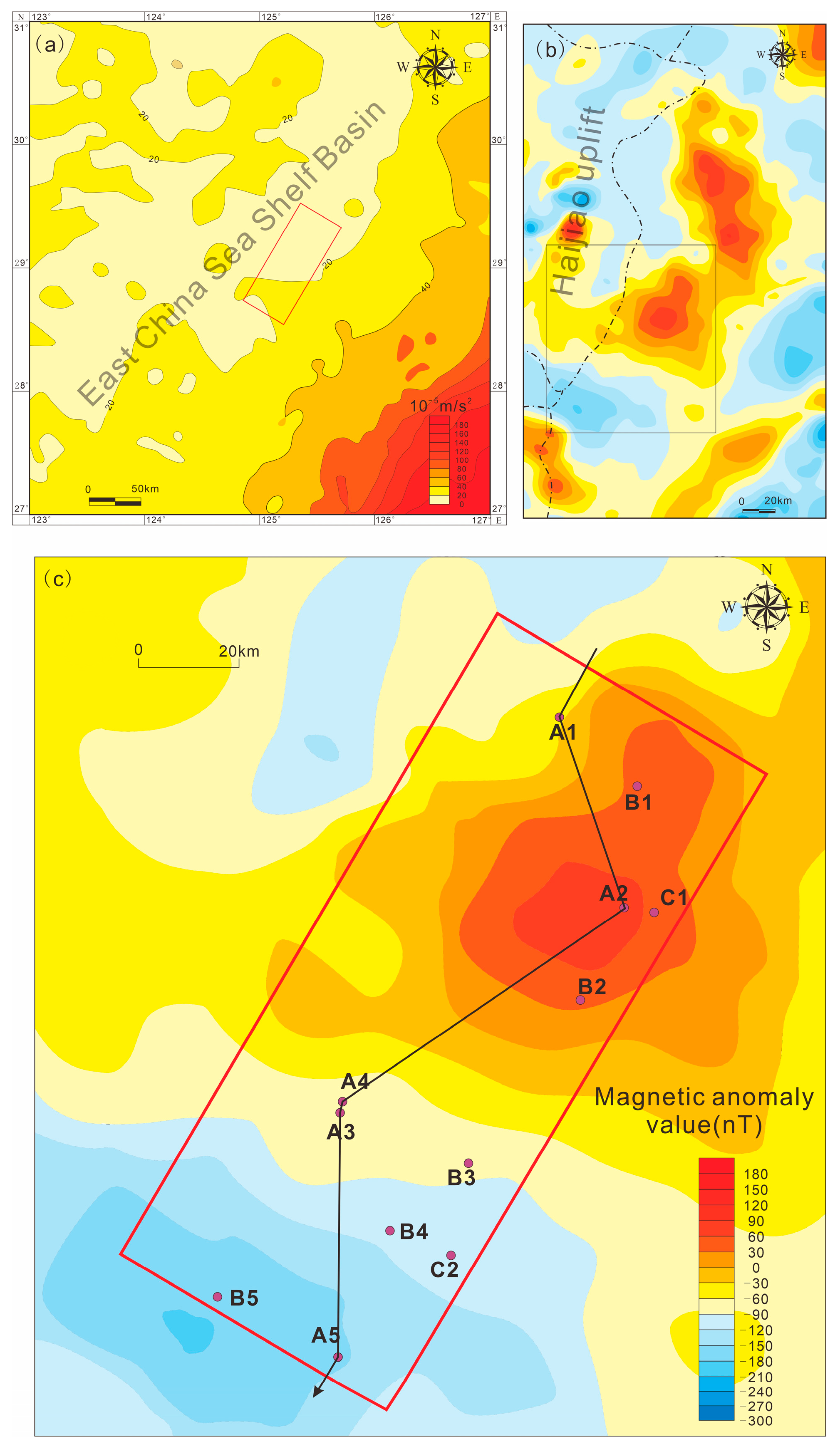Paleogeomorphology Restoration of Post-Rift Basin: Volcanic Activity and Differential Subsidence Influence in Xihu Sag, East China Sea
Abstract
1. Introduction
2. Regional Geological Conditions
2.1. Tectonic Events and Volcanic Background
2.2. Sedimentary and Drilling Background
3. Materials and Methods
3.1. Materials
3.2. Restoration Method for Paleogeomorphology
- (1)
- Utilizing the analysis of the T30 and SB31.2 seismic horizons to determine the residual thickness and, subsequently, to finalize the restoration of the residual paleogeomorphology.
- (2)
- Achieve precise measurements of tectonic subsidence and load subsidence in the target strata by utilizing lithological parameters, fully recovering differential subsidence, and reconstructing paleogeomorphology.
3.2.1. Restoration of Residual Paleogeomorphology
3.2.2. Recovery of Differential Subsidence
4. Results and Verification
5. Discussion
5.1. The Advantages and Application of This Method
5.2. Inspiration for Dynamic Geomorphological Evolution
6. Conclusions
Author Contributions
Funding
Institutional Review Board Statement
Informed Consent Statement
Data Availability Statement
Acknowledgments
Conflicts of Interest
References
- Guidish, T.M. Basin evaluation using burial history calculations: An overview. AAPG Bull. 1985, 69, 92–104. [Google Scholar]
- Katz, B.J.; Pheifer, R.N.; Schunk, D.J. Interpretation of Discontinuous Vitrinite Reflectance Profiles. AAPG Bull. 1988, 72, 926–931. [Google Scholar]
- Wang, H.; Huang, C.Y.; Zhao, S.E.; Yan, D.T.; Bai, Y.F.; Xiang, X.M.; Chen, S.; Xia, C.Y.; Liao, J.H. Paleogeomorphy, provenance system and sedimentary system of the Dongying formation in the Qikou sag. Min. Sci. Technol. 2009, 19, 800–806. [Google Scholar] [CrossRef]
- Fu, J.H.; Li, S.X.; Xu, L.M.; Niu, X.B. Paleo-sedimentary environmental restoration and its significance of Chang 7 Member of Triassic Yanchang Formation in Ordos Basin, NW China. Pet. Explor. Dev. 2018, 45, 998–1008. [Google Scholar] [CrossRef]
- Zhao, Q.; Zhu, H.T.; Zhang, X.D.; Liu, Q.H.; Li, M. Geomorphologic reconstruction of an uplift in a continental basin with a source-to-sink balance: An example from the Huizhou-Lufeng uplift, Pearl River Mouth Basin, South China Sea. Mar. Pet. Geol. 2021, 128, 104984. [Google Scholar] [CrossRef]
- Deng, H.W.; Wang, H.L.; Wang, D.Z. Control of paleomorphology to stratigraphic sequence in continental rift basins: Take lower tertiary of western slope in Bozhong depression as an example. Oil Gas Geol. 2001, 22, 293–296. [Google Scholar]
- Wu, X.S.; Fan, T.L. The relationship between palaeotopography and reservoir prediction in sequence stratigraphic research. Acta Geosci. Sin. 2002, 23, 259–262. [Google Scholar]
- Chen, S.G.; Ren, J.Y.; Wu, F.; Cui, C.; Zhang, J.L. Palaeogeomorphic recovery and its application in shabei area, central bohai depression. Spec. Oil Gas Reserv. 2015, 22, 52–55. [Google Scholar]
- Xian, B.; Wang, Z.; Ma, L.; Chao, C.; Pu, Q.; Jing, A.; Wang, J. Paleo-drainage system and integrated paleo-geomorphology restoration in depositional and erosional areas: Guantao Formation in east liaodong area, bohai bay basin, China. Earth Sci. 2017, 42, 1922–1935. [Google Scholar]
- Jiang, Y.M.; Zou, W.; Liu, J.S.; Tang, X.J.; He, J.X. Genetic mechanism of inversion anticline structure at the end of Miocene in Xihu Sag, East China Sea: A new understanding of basement structure difference. J. Earth Sci. 2020, 45, 968–979. [Google Scholar]
- Liu, H.; Tang, Y.; Tan, X.; He, B.; Tang, S.; Zhou, Y.; Lin, B. Paleogeomorphological reconstruction and geological implications of the weathered-crust karst on the top of the Middle Triassic Leikoupo Formation in the Longgang area, Sichuan Basin, China. Energy Explor. 2017, 36, 727–742. [Google Scholar] [CrossRef]
- Liu, J.E.; Jian, X.L.; Kang, B.; Su, M.; Du, X.B. Paleogeomorphology of the middle part of 3rd member of Shahejie formation and their effects on depositional systems, Dongying delta, Dongying depression. Petrol. Pet. Geol. Recovery Effic. 2014, 21, 20–23. [Google Scholar]
- Zeng, Z.W.; Yang, X.H.; Shu, Y.; Chen, S.H.; Wu, J.; Wang, W.; Xia, C.C. Structure palaeogeomorphology characteristics and sand bodies distribution regularities of paleogene Wenchang Formation in enping sag: Under the conditions of lack of drilling data to predict and evaluate the reservoir sand bodies. Geoscience 2015, 29, 804–815. [Google Scholar]
- Wang, C.J.; Huang, X.B.; Guo, T.; Xie, J.; Guo, R.; Yao, C. High precision paleotopography restoration technology and its application: Taking the second member of dongying strata in the South of liaoxi uplift as an example. Geoscience 2017, 31, 1214–1221+1240. [Google Scholar]
- Seraj, M.; Faghih, A.; Motamedi, H.; Soleimany, B. Major Tectonic Lineaments Influencing the Oilfields of the Zagros Fold-Thrust Belt, SW Iran: Insights from Integration of Surface and Subsurface Data. J. Earth Sci. 2020, 31, 596–610. [Google Scholar] [CrossRef]
- Chen, W.D.; Chen, Y.C.; Xu, F.B.; Li, S.L.; Li, Y.J.; Zeng, L.Y.; Tan, Q.; Kang, N. Stratigraphic division and correlation and karst paleogeomorphology restoration of the Middle Permian Maokou Formation in the eastern Sichuan Basin. Nat. Gas Ind. 2021, 41, 27–36. [Google Scholar]
- Zhang, Y.F.; Wang, Z.Y.; Qu, H.Z.; Luo, C.S.; Li, Y. Sedimentary microtopography in sequence stratigraphic framework of Upper Ordovician and its control over penecontemporaneous karstification, No. I slope break, Tazhong, Tarim block. J. Cent. South Univ. 2014, 21, 735–744. [Google Scholar] [CrossRef]
- He, W.J.; Zheng, M.L.; Fei, L.Y.; Wu, A.C.; Yang, T.Y.; Ding, J. Ancient landform restoration of marginal sedimentary area in the continental depression basin: A case study of the Triassic Baikouquan Formation in Mahu area of Junggar Basin. J. Paleogeogr. 2019, 21, 803–816. [Google Scholar]
- Liu, J.S.; Xu, H.Z.; Jiang, Y.M.; Wang, J.; He, X.J. Mesozoic and Cenozoic basin structure and tectonic evolution in the East China Sea basin. Acta Geol. Sin. 2020, 94, 675–691. [Google Scholar]
- Lee, E.Y.; Novotny, J.; Wagreich, M. Subsidence Analysis and Visualization: For Sedimentary Basin Analysis and Modelling; Springer: Berlin/Heidelberg, Germany, 2018. [Google Scholar]
- Kim, Y.; Huh, M.; Lee, E.Y. Numerical modelling to evaluate sedimentation effects on heat flow and subsidence during continental rifting. Geosciences 2020, 10, 451. [Google Scholar] [CrossRef]
- Tapponnier, P.; Peltzer, G.; Armijo, R. On the mechanics of the collision between India and Asia. Geol. Soc. Publ. 1986, 19, 113–157. [Google Scholar] [CrossRef]
- Schieber, J.; Zimmerle, W. The history and promise of shale research. In Shales and Mudstones; Schieber, J., Zimmerle, W., Sethi, P., Eds.; I. Basin Studies, Sedimentology and Paleontology; Schweizerbart’sche Verlagsbuchhandlung: Stuttgart, Germany, 1998; Volume 1. [Google Scholar]
- Aplin, A.C.; Macquaker, J.H.S. Mudstone diversity: Origin and implications for source, seal, and reservoir properties in petroleum systems. AAPG Bull. 2011, 95, 2031–2059. [Google Scholar] [CrossRef]
- Lemgruber-Traby, A.; Espurt, N.; Souque, C.; Henry, P.; Calderon, Y.; Baby, P.; Brusset, S. Thermal structure and source rock maturity of the North Peruvian forearc system: Insights from a subduction-sedimentation integrated petroleum system modeling. Mar. Pet. Geol. 2020, 122, 46–64. [Google Scholar] [CrossRef]
- Jia, R.Y.; Liu, Q.H.; Zhu, H.T.; Qin, L.Z.; Xu, D.H.; Li, Z.Y.; Sun, Z.H. Quantitative Pickup of High Frequency Sequence-Time Units under Restriction of Milankovitch Sedimentary Rate in Continental Shallow Lake Basin: A Case Study of Huagang Formation in Huangyan Area, Xihu Sag. J. Earth Sci. 2022, 47, 4020–4032. [Google Scholar]
- Yang, F.; Yu, H.; Zhang, Q.; Li, Q. Correlations between shortening rate, uplift rate, and inversion rate in central inversion zone of Xihu depression, East China Sea basin. J. Earth Sci. 2009, 20, 699–708. [Google Scholar] [CrossRef]
- Jiang, M.; Chen, D.; Chang, X.; Shu, L.; Wang, F. Controlling effect of tectonic-paleogeomorphology on deposition in the south of lufeng sag, pearl river mouth basin. Adv. Geo-Energy Res. 2022, 6, 363–374. [Google Scholar] [CrossRef]
- Zhao, Z.G.; Wang, P.; Qi, P.; Guo, R. Regional Background and Tectonic Evolution of East China Sea Basin. Earth Sci. 2016, 41, 546–554. [Google Scholar]
- Guo, Z. Evolutionary Important Geological Phenomena and Its Dynamics Background in East China Sea Shelf Basin. Ph. D. Thesis, Northwest University, Kirkland, WA, USA, 2015. [Google Scholar]
- Yang, W.D.; Cui, Z.K.; Zhang, Y.B. Geology and Minerals in the East China Sea. China Ocean Press: Beijing, China, 2010. [Google Scholar]
- Li, B.F.; Jiao, X.H.; Liu, B.H. Discussion on Seismic Reflection Characteristics of Igneous Rock in Diaoyu Island Uplift, East China Sea. Oil Geophys. Prospect. 1995, 30, 150–154. [Google Scholar]
- Tang, X.J.; Jiang, Y.M.; Zhang, S.L. Tectonic environment of volcanic rocks in the Pinghu Slope Belt and its petroleum geological significance. Geol. Sci. Technol. Inf. 2018, 37, 27–36. [Google Scholar]
- Geological Survey of Japan and Coordinating Committee for Coastal and Offshore Geoscience Programmes in East and Southeast Asia (CCOP). Magnetic Anomaly Map of East Asia 1:4,000,000 CD-ROM Version; Digital Geoscience Map 2 (P-1); Geological Survey of Japan: Tsukuba, Japan, 1996. [Google Scholar]
- Oldenburg, D.W. The Inversion and interpretation of gravity anomalies. Geophysics 1974, 39, 526–536. [Google Scholar] [CrossRef]
- Mancinelli, P.; Scisciani, V.; Patruno, S.; Minelli, G. Gravity modeling reveals a Messinian foredeep depocenter beneath the intermontane Fucino Basin (Central Apennines). Tectonophysics 2021, 821, 229144. [Google Scholar] [CrossRef]
- Baranov, V. A New Method for Interpretation of Aeromagnetic Maps: Pseudo-Gravimetric Anomalies. Geophysics 1957, 22, 359–382. [Google Scholar] [CrossRef]
- Books, K.G. Remanent Magnetism as a Contributor to Some Aeromagnetic Anomalies. Geophysics 1962, 27, 359–375. [Google Scholar] [CrossRef]
- Hermance, J.F.; Neumann, G.A. Magnetic variations in the reconnaissance of sedimentary basins: Field procedure and generalized inversion of short-period data from the Rio Grande rift. Geophysics 1990, 55, 1567–1576. [Google Scholar] [CrossRef]
- Davy, B.; Stagpoole, V.; Yu, D.B. Subsurface structure of the Canterbury region interpreted from gravity and aeromagnetic data. N. Z. J. Geol. 2012, 55, 185–191. [Google Scholar] [CrossRef]
- Han, B. Geophysical Field and Deep Tectonic Features of East China Sea. Ph. D. Thesis, Institute of Oceanology, University of Chinese Academy of Sciences, Qingdao, China, 2008. [Google Scholar]
- Richards, M.A.; Duncan, R.A.; Courillot, V.E. Flood basalts and hot spot tracks: Plume heads and tails. Science 1989, 246, 103–107. [Google Scholar] [CrossRef] [PubMed]
- Coffin, M.F.; Eldholm, M. Large Igneous Provinces: JOI/USSAC Workshop Report. Technical Report 114; University of Texas at Austin Institute for Geophysics: Austin, TX, USA, 1991; 79p. [Google Scholar]
- Bryan, S.; Ernst, R.E. Revised definition of Large Igneous Provinces (LIPs). Earth-Sci. Rev. 2008, 86, 175–202. [Google Scholar] [CrossRef]
- Campbell, I.H.; Griffiths, R.W. Implications of mantle plume structure for the evolution of food basalis. Earth Planet. Sci. Lett. 1990, 99, 79–93. [Google Scholar] [CrossRef]
- Campbell, I.H. Large Igneous Provinces and the Mantle Plume Hypothesis. Elements 2005, 1, 265–269. [Google Scholar] [CrossRef]
- Mckenzie, D.A.N.; Bickle, M.J. The volume and composition of melt generated by extension of the lithosphere. J. Petrol. 1988, 29, 625–679. [Google Scholar] [CrossRef]
- Xu, Y.G.; He, B.; Huang, X. Identification of mantle plumes in the Emeishan Large Igneous Province. Epis. J. Int. Geosci. 2007, 30, 32–42. [Google Scholar] [CrossRef] [PubMed]
- Sclater, J.G.; Christie, P.A. Continental stretching: An explanation of the post-mid-Cretaceous subsidence of the central North Sea basin. J. Geophys. Res. Solid Earth 1980, 85, 3711–3739. [Google Scholar] [CrossRef]
- Yan, W.T. Analysis of Sedimentary Facies on Huangyan Formation of Oligocene in Xihu Sag of East China Sea Shelf Basin; Ocean University of China: Qingdao, China, 2007. [Google Scholar]
- Chen, S.; Zhao, R.; Chen, C.G.; Wang, H.; Ma, J.H.; Gong, T.H.; Yu, Z.H. Tectono-sedimentary evolution of the Paleogene Qikou Sag, Bohai Bay Basin, NE China. Mar. Pet. Geol. 2023, 148, 106057. [Google Scholar] [CrossRef]
- Wu, Z.P.; Zhou, Y.Q. Using the characteristic elements from meteoritic must in strata to calculate sedimentation rate. Acta Sedimentol. Sin. 2000, 18, 395–399. [Google Scholar]
- Zhang, C.L.; Gao, A.L.; Liu, Z.; Huang, J.; Yang, Y.J.; Zhang, Y. Study of Character on Sedimentary Water and Palaeoclimate for Chang7 Oil Layer in Ordos Basin. Nat. Gas Geosci. 2011, 22, 582–587. [Google Scholar]
- Oostingh, K.F.; Jourdan, F.; Matchan, E.L.; Phillips, D. 40Ar/39Ar geochronology reveals rapid change from plume-assisted to stress-dependent volcanism in the Newer Volcanic Province, SE Australia. Geochem. Geophys. Geosyst. 2017, 18, 1065–1089. [Google Scholar] [CrossRef]
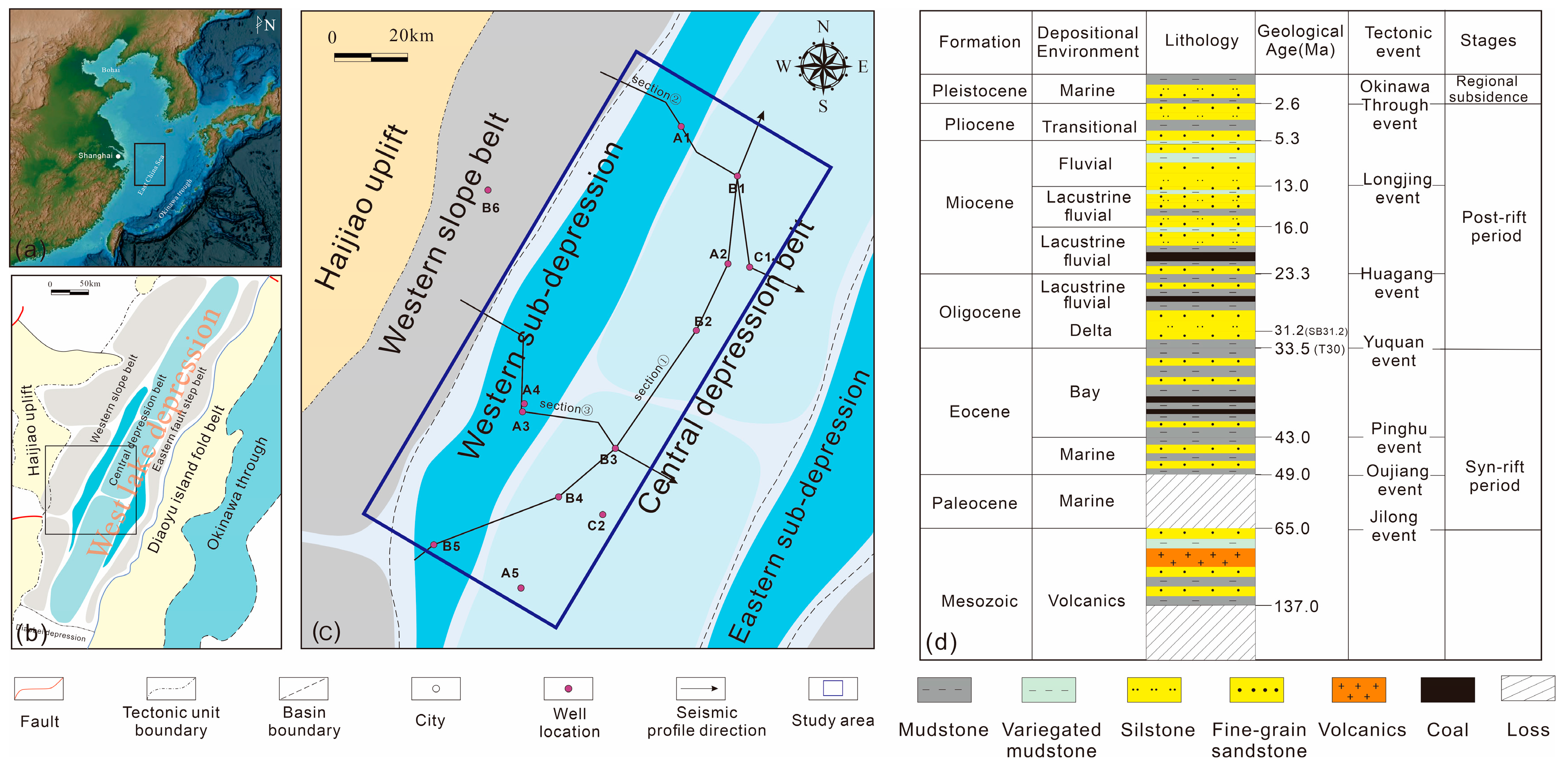
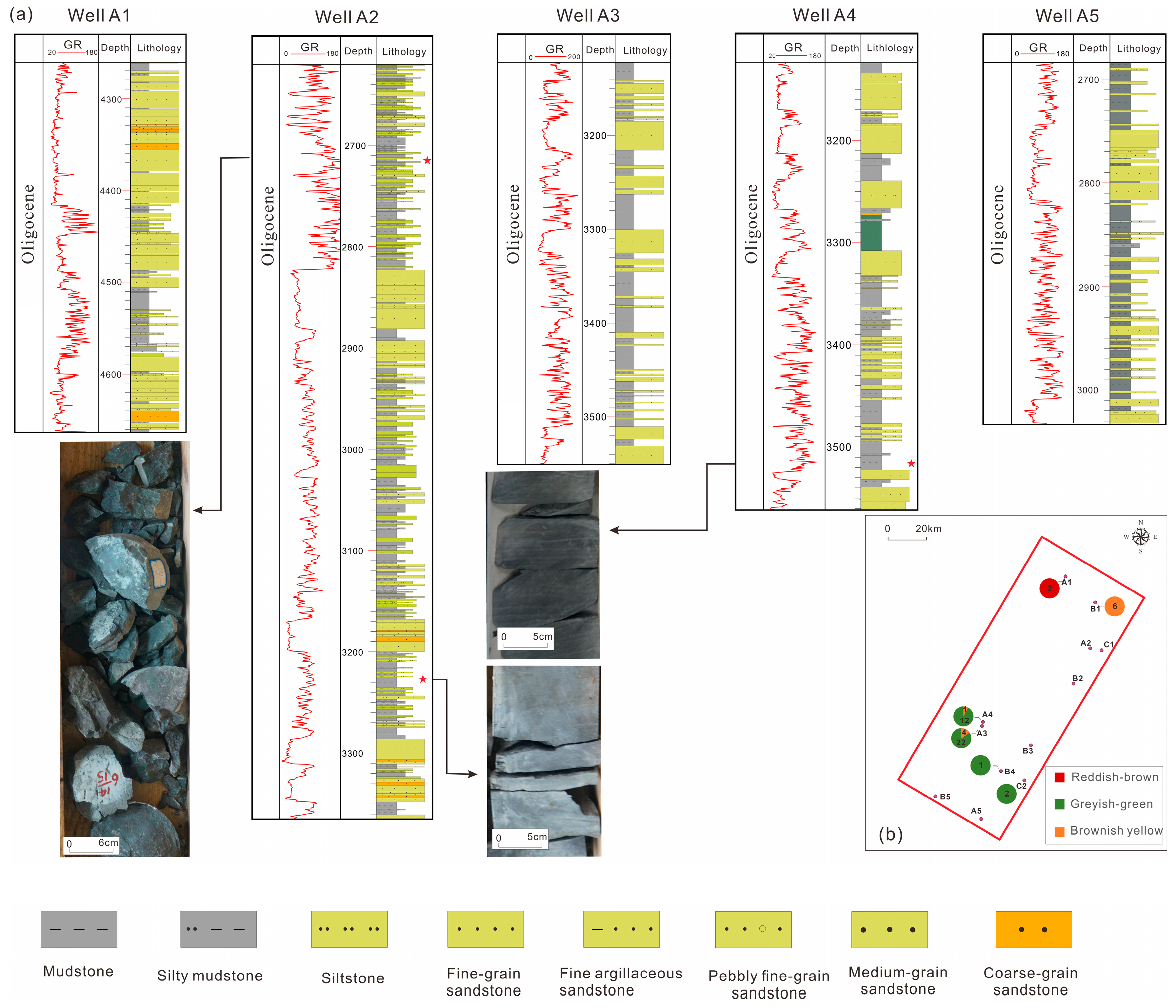
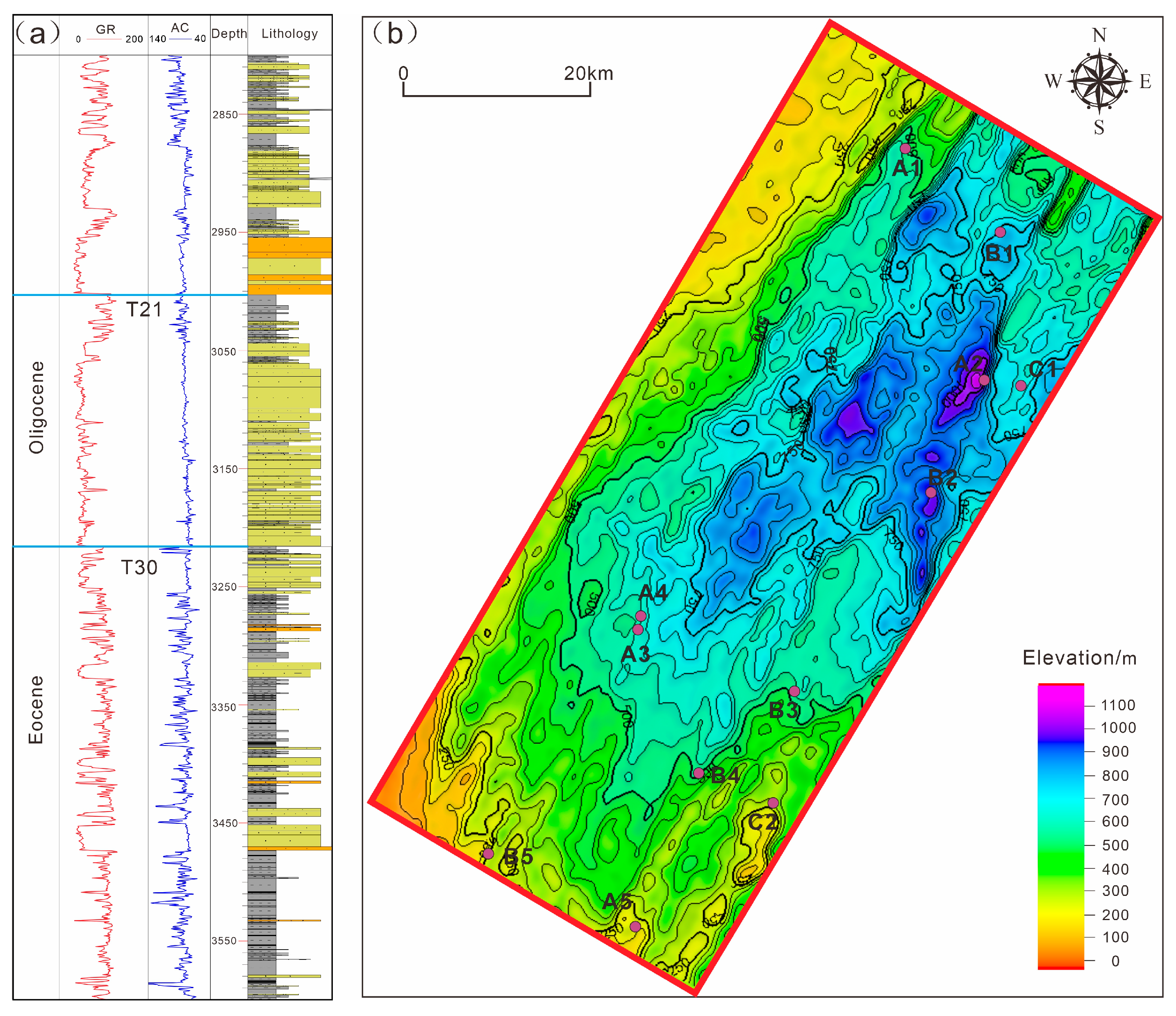

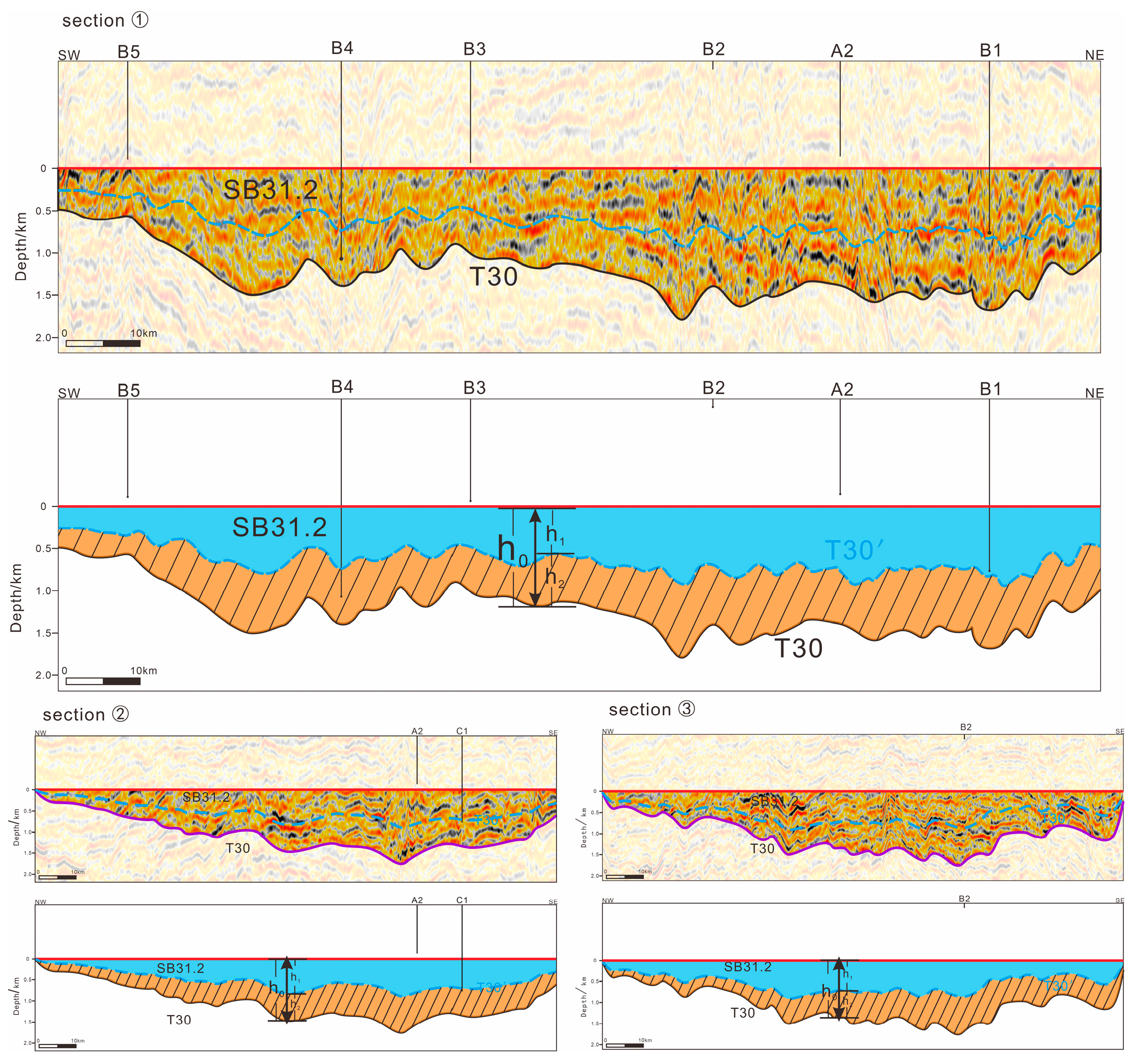
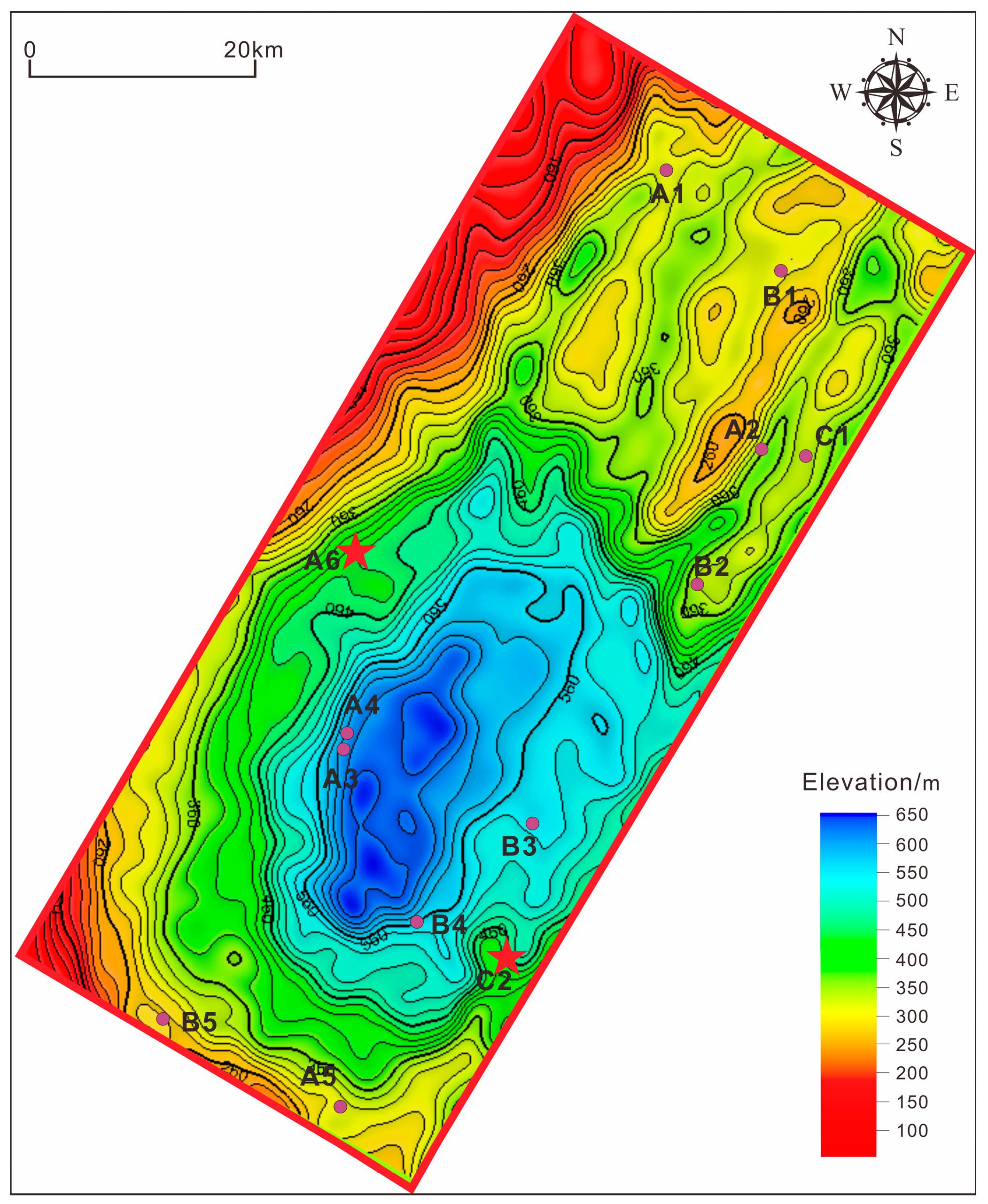
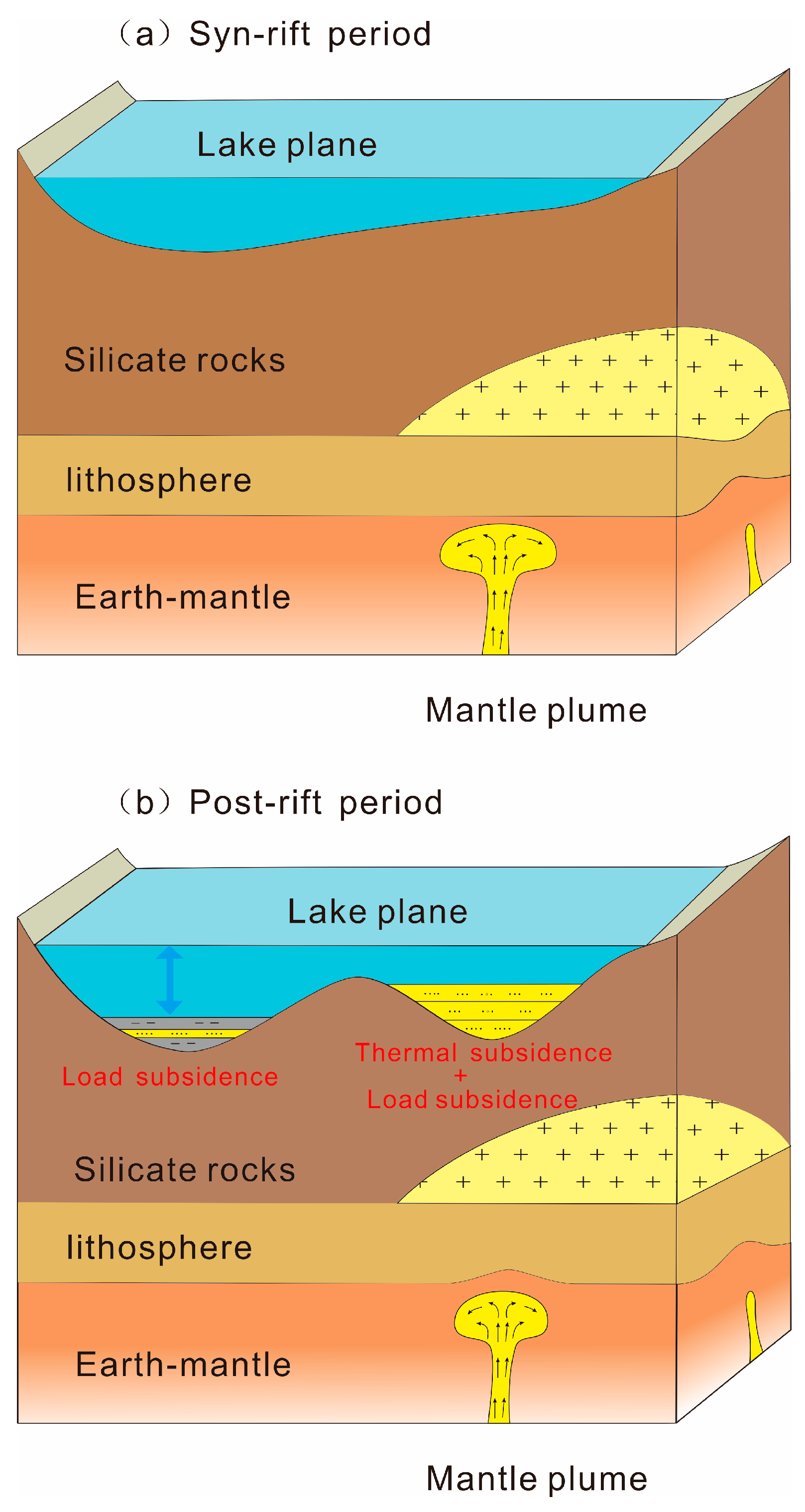
| Well Name | Co/ppm | La/ppm | Paleowater Depth/m |
|---|---|---|---|
| C2 | 16.3 | 35 | 5.3 |
| 22.5 | 33.7 | 9 | |
| A6 | 20.62 | 49.67 | 6.8 |
| Type | Material | Advantage | Limitation |
|---|---|---|---|
| Residual stratum thickness | Seismic interpretation | High accuracy for deposition area | Not suitable for denudation area |
| Sequence stratigraphy | Sequence interpretation results (initial flooding surface, super-cusp extinction line on maximum flooding surface, slope broken line, fold shape) | Conducive to the fine correlation of reservoirs | An ideal research idea cannot adapt to the complex research environment. |
| Back-stripping technology | formation thickness, compaction, porosity, age | Better restore the geomorphological characteristics of low-lying landform | Restoration results are not reliable for the denuded area |
| Geophysics | Seismic interpretation, synthetic seismogram | High accuracy | Highly dependent on the fineness of seismic data, it can not adapt to complex geological environments. |
| Sedimentation | Geological map, stratum thickness map, sandstone thickness map, lithofacies palaeogeographic map | Simple and basic | Low accuracy |
Disclaimer/Publisher’s Note: The statements, opinions and data contained in all publications are solely those of the individual author(s) and contributor(s) and not of MDPI and/or the editor(s). MDPI and/or the editor(s) disclaim responsibility for any injury to people or property resulting from any ideas, methods, instructions or products referred to in the content. |
© 2024 by the authors. Licensee MDPI, Basel, Switzerland. This article is an open access article distributed under the terms and conditions of the Creative Commons Attribution (CC BY) license (https://creativecommons.org/licenses/by/4.0/).
Share and Cite
Yu, X.; Liu, Q.; Zhu, H.; Li, Z.; Qin, L.; Xu, D. Paleogeomorphology Restoration of Post-Rift Basin: Volcanic Activity and Differential Subsidence Influence in Xihu Sag, East China Sea. J. Mar. Sci. Eng. 2024, 12, 1542. https://doi.org/10.3390/jmse12091542
Yu X, Liu Q, Zhu H, Li Z, Qin L, Xu D. Paleogeomorphology Restoration of Post-Rift Basin: Volcanic Activity and Differential Subsidence Influence in Xihu Sag, East China Sea. Journal of Marine Science and Engineering. 2024; 12(9):1542. https://doi.org/10.3390/jmse12091542
Chicago/Turabian StyleYu, Xiongbiao, Qianghu Liu, Hongtao Zhu, Zhiyao Li, Lanzhi Qin, and Donghao Xu. 2024. "Paleogeomorphology Restoration of Post-Rift Basin: Volcanic Activity and Differential Subsidence Influence in Xihu Sag, East China Sea" Journal of Marine Science and Engineering 12, no. 9: 1542. https://doi.org/10.3390/jmse12091542
APA StyleYu, X., Liu, Q., Zhu, H., Li, Z., Qin, L., & Xu, D. (2024). Paleogeomorphology Restoration of Post-Rift Basin: Volcanic Activity and Differential Subsidence Influence in Xihu Sag, East China Sea. Journal of Marine Science and Engineering, 12(9), 1542. https://doi.org/10.3390/jmse12091542





